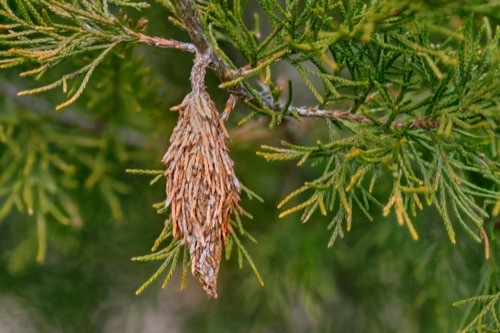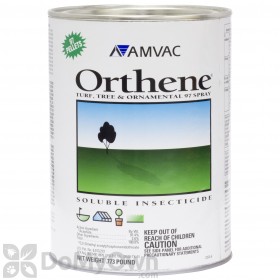
These unique, destructive caterpillars occur most often in the eastern United States from New England to Nebraska and south through Texas.
The most commonly observed form of this pest is in the "bag" stage. In this stage the bagworm is actually in the larval state of development. The bag is spindle shaped, made from silk and camouflaged with small bits of bark, foliage and other debris obtained from the host tree or plant. Full size bags may range in size from 1.5 -2.5 inches long. The actual worm or larva itself ranges in color from cream to brown and may be mottled with black spots.options)].
Males, when they reach adulthood appear bee-like with furry bodies, and clear wings. The females remain in a larval state and do not emerge from the bag or develop wings.
The larva will stick its head and front legs out of the top of the bag to feed and move. When irritated, the larva will quickly pull its head into the bag and hold the opening closed. Mature larvae may stay on suitable host plants or drag their bags some distance before attaching the bag to change into the adult stage.
Bagworm Life Cycle

In most states there is only one generation per year. Bagworms can be tracked through the different seasons.
- Spring - Egg hatch occurs from late May to early June, at which time the larvae crawl out in search of food. Each constructs a small bag around its hind parts with silk and plant material.
- Summer - Feeding, growth and molting continue until August, at which time the mature larvae attach themselves to twigs. They close the bag and reverse themselves so that they are head down in the bag. They remain there for about 4 weeks as pupae.
- Fall - During September and early October, the female releases a sex attractant pheromone and the males leave their cases and fly to the female bags to mate. Females lay 500-1000 eggs in each bag. There is one generation per year in Pennsylvania.
- Winter - The eggs over-winter inside the bag made by the previous year's female
Bagworm Damage

The young larvae feed on the upper epidermis leaving small brown spots on the leaves. Older larvae strip evergreens of their needles and consume whole leaves of susceptible deciduous species, leaving only the larger veins. Unfortunately, the presence of bagworms often goes unnoticed until they are mature and the damage is extensive and entire trees are killed.
How to Get Rid of Bag Worms

It is important to start control methods before a major infestation occurs. Once the bagworms have matured and have formed the "bag" most chemical control methods will no longer work.
You can manually control bagworms by simply plucking them off of the infested trees and dropping them into a bucket of soapy water or squishing them. This control method is most useful during fall, winter and early spring, before the eggs inside the bag have hatched.
Chemical control may be achieved when the larvae are small and just emerging from the over-wintering bag. Use a concentrated liquid insecticide such as Orthene, Talstar or Tempo. Foliage should be thoroughly wetted with the insecticide spray in order to achieve thorough coverage. When doing an insecticide treatment, timing is key. To find out the correct time of year to treat for bagworms in your region contact you local Cooperative Extension Office. These offices can prove to be invaluable when treating for insect pests.







